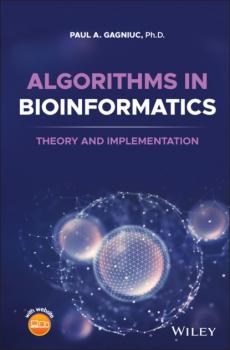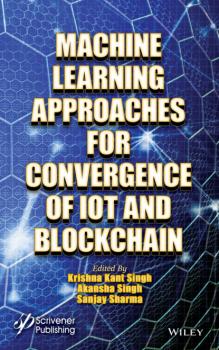John Wiley & Sons Limited
Все книги издательства John Wiley & Sons LimitedAlgorithms in Bioinformatics
ALGORITHMS IN BIOINFORMATICS Explore a comprehensive and insightful treatment of the practical application of bioinformatic algorithms in a variety of fields Algorithms in Bioinformatics: Theory and Implementation delivers a fulsome treatment of some of the main algorithms used to explain biological functions and relationships. It introduces readers to the art of algorithms in a practical manner which is linked with biological theory and interpretation. The book covers many key areas of bioinformatics, including global and local sequence alignment, forced alignment , detection of motifs, Sequence logos, Markov chains or information entropy. Other novel approaches are also described, such as Self-Sequence alignment, Objective Digital Stains (ODSs) or Spectral Forecast and the Discrete Probability Detector (DPD) algorithm. The text incorporates graphical illustrations to highlight and emphasize the technical details of computational algorithms found within, to further the reader’s understanding and retention of the material. Throughout, the book is written in an accessible and practical manner, showing how algorithms can be implemented and used in JavaScript on Internet Browsers. The author has included more than 120 open-source implementations of the material, as well as 33 ready-to-use presentations. The book contains original material that has been class-tested by the author and numerous cases are examined in a biological and medical context. Readers will also benefit from the inclusion of: A thorough introduction to biological evolution, including the emergence of life, classifications and some known theories and molecular mechanismsA detailed presentation of new methods, such as Self-sequence alignment, Objective Digital Stains and Spectral Forecast A treatment of sequence alignment, including local sequence alignment, global sequence alignment and forced sequence alignment with full implementationsDiscussions of position-specific weight matrices, including the count, weight, relative frequencies, and log-likelihoods matricesA detailed presentation of the methods related to Markov Chains as well as a description of their implementation in Bioinformatics and adjacent fieldsAn examination of information and entropy, including sequence logos and explanations related to their meaningAn exploration of the current state of bioinformatics, including what is known and what issues are usually avoided in the fieldA chapter on philosophical transactions that allows the reader a broader view of the prediction processNative computer implementations in the context of the field of BioinformaticsExtensive worked examples with detailed case studies that point out the meaning of different results Perfect for professionals and researchers in biology, medicine, engineering, and information technology, as well as upper level undergraduate students in these fields, Algorithms in Bioinformatics: Theory and Implementation will also earn a place in the libraries of software engineers who wish to understand how to implement bioinformatic algorithms in their products.
Positive Ethics for Mental Health Professionals
Develop a practical and comprehensive view of professional ethics In the newly updated Second Edition of Positive Ethics for Mental Health Professionals: A Proactive Approach, distinguished psychologists Drs. Sharon K. Anderson and Mitchell M Handelsman deliver an insightful guide for mental health professionals and trainees to stregthen and/or develop their professional and ethical identities. Utilizing the same informal and inviting tone of the first edition, Anderson and Handelsman share the literature and provide positive discussions, exercises, case scenarios, and writing assignments, to help you explore and develop your ethical core. You'll also develop your self-reflective skills to learn how to make excellent ethical choices regarding psychotherapy and couseling. This edition of the book also offers: An introduction of the idea of «tripping points», or predictable pitfalls, when making ethical choices. Discussions of nonrational factors in ethical decision-making, including biases, heuristics, and emotional influences. A renewed focus on ethical acculturation, which emphasizes the importance of your own background in the development of your ethical identity. Perfect for undergraduate and graduate students studying psychotherapy and mental health counseling, Positive Ethics for Mental Health Professionals , will also earn a place in the libraries of mental health practitioners seeking a primer on the complicated ethical issues that inevitably arise in their practices- and how to prepare for them and navigate them.
Iceland Within the Northern Atlantic, Volume 1
The volcanic island of Iceland is a unique geological place due both to its position in the middle of the Atlantic Ocean and its repeated glaciations. It has been an accurate recorder of geodynamic and regional climatic evolutions for at least the last 15 million years.<br /><br />This book traces the history of Iceland, which is linked to the opening of the North Atlantic and the reactivation of the ancient suture of the Iapetus Ocean. It gives a view of climate evolution that is partly controlled by the dynamics of the ocean floor and analyzes the movement of the Jan Mayen tectonic plate and the progressive insularization of the Greenland–Faroe Ridge, which gave birth to Iceland. It also tries to understand the formation and migration of the deep Iceland hotspot and the lava flows that have, for millions of years, shaped this island.<br /><br />This book brings together the internal and external geodynamics of our planet to understand how Iceland functions and its role as a recorder of the paleoclimatic evolution of the Northern Hemisphere.
Arc Welding Processes Handbook
Written by a welding/metallurgical engineer with over 40 years of experience, Arc Welding Processes Handbook delivers the welding and materials expertise required to master complex welding processes and techniques to ensure that the task is done correctly and safely. While reinforcing an understanding of international welding standards and rules. The prefect handbook for those professionals who need an “up- to-date” reference to advance processes as well as those welders new to the field and need to hone their skills. Arc Welding Processes Handbook five-part treatment starts with a clear and rigorous exposition of the applications and equipment of Shielded Metal Arc Welding (SMAW) and Gas Tungsten Arc Welding (GTAW), followed by self-contained parts concerning processes applications and equipment for Gas Metal Arc Welding (GMAW), Flux Core Arc Welding (FCAW), and Submerged Arc welding (SAW). Case studies taken directly from the field are included to highlight each part of the handbook. An applied reference, each Part of Arc Welding Processes Handbook offersvaluable advice regarding the industry or industries where the process is commonly used as well as a description the equipment. The Handbook reaches deeply into the area of nondestructive testing and science. In addition, this Handbook discusses the challenges presented by a number of corrosion-resistant alloys (CRAs). Case studies are included throughout the reference to reinforce an understanding of how these processes were applied in the field and how they intersect with issues that may arise with equipment use and materials.
Machine Learning Approaches for Convergence of IoT and Blockchain
The digital revolution is characterized by the convergence of technologies, rapidly advancing the 4th industrial revolution thereby blurring the lines between physical, digital and biological objects. The speed of the fourth revolution which evolves at an exponential rate cannot by any means be compared with any previous technologies. AI and IoT employ the interactions and operations in various fields such as home appliances, autonomous vehicles, nanotechnology, robotics, cognitive systems, self-driving cars and wearable devices. The potential of blockchain technology is realized in many sectors as security plays a crucial role everywhere. This book deeply discusses two of the most critical emerging fields of machine learning: blockchain technology and the Internet of Things.
Fundamentals of Terahertz Devices and Applications
An authoritative and comprehensive guide to the devices and applications of Terahertz technology Terahertz (THz) technology relates to applications that span in frequency from a few hundred GHz to more than 1000 GHz. Fundamentals of Terahertz Devices and Applications offers a comprehensive review of the devices and applications of Terahertz technology. With contributions from a range of experts on the topic, this book contains in a single volume an inclusive review of THz devices for signal generation, detection and treatment. Fundamentals of Terahertz Devices and Applications offers an exploration and addresses key categories and aspects of Terahertz Technology such as: sources, detectors, transmission, electronic considerations and applications, optical (photonic) considerations and applications. Worked examples—based on the contributors' extensive experience— highlight the chapter material presented. The text is designed for use by novices and professionals who want a better understanding of device operation and use, and is suitable for instructional purposes This important book: Offers the most relevant up-to-date research information and insight into the future developments in the technology Addresses a wide-range of categories and aspects of Terahertz technology Includes material to support courses on Terahertz Technology and more Contains illustrative worked examples Written for researchers, students, and professional engineers, Fundamentals of Terahertz Devices and Applications offers an in-depth exploration of the topic that is designed for both novices and professionals and can be adopted for instructional purposes.
Practical Procedures in Implant Dentistry
Master the fundamentals and intricacies of implant dentistry with this comprehensive and practical new resource Practical Procedures in Implant Dentistry delivers a comprehensive collection of information demonstrating the science and clinical techniques in implant dentistry. Written in a practical and accessible style that outlines the principles and procedures of each technique, the book offers clinical tips and references to build a comprehensive foundation of knowledge in implantology. Written by an international team of contributors with extensive clinical and academic expertise, Practical Procedures in Implant Dentistry covers core topics such as: Rationale and assessment for implant placement and restoration, including the diagnostic records and surgical considerations required for optimal planning and risk management Incision design considerations and flap management, with an essential knowledge of regional neuro-vascular structures Implant placement, encompassing the timing of the placement, bone requirements and understanding the importance of the peri-implant interface for soft tissue stability Impression techniques, loading protocols, digital workflows and the aesthetic considerations of implants Prosthetic rehabilitation of single tooth implants to fully edentulous workflows, including discussions of soft tissue support, biomechanics and occlusal verification Perfect for both general dental practitioners and specialists in implant dentistry, Practical Procedures in Implant Dentistry is also a valuable reference to senior undergraduate and postgraduate dental students.









